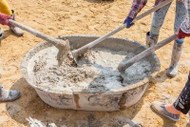Concrete Arts
Published by Sam Morey on Jul 3rd 2018
Concrete art: Sculptures and decorations formed by casting concrete into the shape of your choice. Originally just for benches and stepping stones, this art style is becoming increasingly popular worldwide. A quick hop over to Etsy shows that many people are making a living off of it. And of course there’s always a small selection at most home and garden stores.
But maybe you’re looking for something a little more personal than a plain white birdbath or a dour-looking gargoyle. Concrete art is something anyone can make themselves! With a little time and effort you can craft something completely unique.
The Appeal of Concrete Art
Concrete art has a more permanent and expensive feel to it than other lawn decorations. It’s picturesque, like a perfectly preserved brick or stone building. (And it’s something a little too heavy to blow away in a windstorm.)
Traditionally it sits in gardens and on porches, but many people are starting to branch out into all manner of household décor, from jewelry stands to coasters. So if you’re a concrete artist yourself, don’t let anything but your imagination hold you back!
Some Concrete Tips
Whether you’ve made a thousand concrete masterpieces in your life or zero, here are a few helpful pointers.
● Try It with Mesh
Most concrete art is made by casting into a form. But casting onto a form can be done as well. Try creating a solid, but hollow sculpture topped with wire mesh and cover the outside of it in cement. This has the added benefit of making much lighter artwork.
● Use Expansion Joint Sealant
For sculptures that requires bringing together multiple pieces of concrete, an expansion joint sealant is necessary. You are most likely familiar with expansion joint sealant from its use on sidewalks, in between the concrete slabs. It’s used there for a couple reasons: firstly, it allows the material to contract and expand with changing temperatures, and secondly, it keeps rain water from getting in between or underneath the slabs and ruining your concrete. The same resistance to the elements is necessary for just about any exterior use of concrete. Rain can damage your art if you leave exposed joints for it to get into.
● One Man’s Trash Is Another Man’s Art.
Maybe not in the most literal sense, but consider incorporating “trash” into your art piece. Concrete will hold onto just about anything touching it while it sets, so go a bit crazy with the add-ons. Twine, twigs, small metal springs or bolts. Especially if you’re making dishes or tiles, these little tokens will really spice things up!
Don’t forget to experiment on your own, either. Concrete art is just that, art. And it won’t grow or evolve unless its artists break the rules sometimes.

